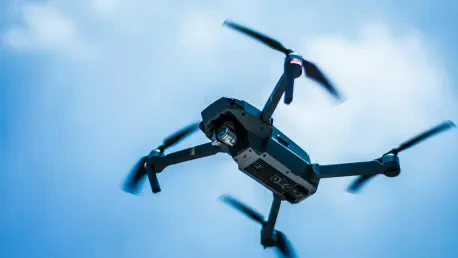What happens when a tiny device, no bigger than a backpack, can disrupt an airport, smuggle contraband into a prison, or spy on a private backyard undetected? This isn’t a plot from a sci-fi thriller—it’s the reality of illegal drone activity sweeping across the nation in 2025, and state leaders are grappling with an invisible menace that’s growing faster than regulations can keep up, forcing them to act before disaster strikes. From Louisiana to Wisconsin, the fight against rogue drones is reshaping laws, technology, and public safety in ways that demand attention.
The importance of this issue cannot be overstated. With over 100 drone-related incidents reported monthly near airports by the Federal Aviation Administration (FAA), the risks to aviation safety, national security, and personal privacy are escalating. States are stepping into a regulatory void left by slow federal action, crafting bold solutions to protect their citizens. This story dives into why drones have become a pressing threat and how state governments are pioneering defenses against a danger that’s literally above the law.
Why Drones Have Become a Critical Security Issue
Drones, once seen as mere gadgets for hobbyists, have morphed into tools of disruption and crime. Their affordability and accessibility allow almost anyone to own a device capable of bypassing traditional security measures. Whether it’s hovering near a crowded stadium or delivering drugs to inmates, the potential for harm is no longer theoretical—it’s documented in rising incident reports across the country. State leaders are sounding the alarm as these small machines challenge the very notion of safety in public spaces.
The numbers paint a stark picture. Beyond the FAA’s monthly tally of airport disruptions, cases of drones invading restricted zones like military bases or critical infrastructure are becoming routine. This isn’t just about inconvenience; it’s about the real possibility of a drone colliding with a passenger jet or enabling a terrorist act. The urgency to address this issue has pushed state capitals into action, as waiting for a catastrophe is no longer an option.
The Escalating Danger of Unauthorized Drone Operations
Beyond the headlines, the consequences of illegal drone use touch everyday lives in unsettling ways. Picture a drone crashing into a backyard barbecue, capturing private moments with a mounted camera, or worse, dropping hazardous materials in a public park. These scenarios highlight how rogue operators threaten not just high-profile targets but also ordinary citizens who expect safety in their own neighborhoods.
Moreover, the criminal applications are growing bolder. Prisons report drones being used to smuggle weapons and narcotics, undermining security protocols with ease. The potential for espionage or coordinated attacks adds another layer of concern, especially near sensitive government facilities. This pervasive risk has forced state officials to rethink how to protect both public welfare and individual rights in an era where the sky is no longer a safe boundary.
State Initiatives Filling the Federal Void
With federal regulations lagging behind the rapid pace of drone technology, states are taking matters into their own hands. Louisiana has emerged as a trailblazer with its “We Will Act” Act, a law that empowers law enforcement to disable threatening drones using both physical and electronic means. This legislation marks a significant shift, giving local authorities tools to respond where federal oversight falls short.
In parallel, Wisconsin is advancing bills to prohibit drone activity over schools and to equip officers with the authority to intercept rogue devices posing immediate risks. These state-specific measures reflect a broader frustration with the FAA’s slow response and the complex jurisdictional maze of airspace control. Through advocacy with groups like the National Governors Association, states are pressing Congress for clearer guidelines and greater autonomy to tackle local threats effectively.
The tension between federal authority and state action remains a sticking point. While the FAA retains ultimate control over whether a drone can be neutralized, state leaders argue that immediate dangers require swift, localized decisions. This clash underscores a critical need for coordination, as patchwork policies risk creating confusion in a domain that demands precision and unity.
Insights from Leaders and Experts on the Drone Crisis
Voices from across the spectrum are amplifying the call for action. Louisiana Governor Jeff Landry has positioned his state as a vanguard in this fight, declaring, “Protecting our people and our skies isn’t optional—it’s our duty.” His stance reflects a growing sentiment among state executives that waiting for federal solutions is a luxury they can’t afford when public safety hangs in the balance.
Industry experts echo this urgency. Brett Feddersen of D-Fend Solutions has criticized congressional inaction, stating, “The gap in addressing privacy and safety concerns with drones is glaring—states are forced to innovate because Washington won’t.” Law enforcement officials, too, express frustration over unclear legal boundaries, citing real cases where delays in authorization allowed rogue drones to escape accountability. These perspectives paint a vivid picture of a crisis demanding immediate, decisive responses.
The human element of this issue comes through in stories from the ground. Officers recount near-misses at public events, while residents near airports voice fears of unseen threats overhead. These firsthand accounts add weight to the argument that state-level intervention isn’t just policy—it’s a direct response to the lived anxieties of communities under siege from above.
Innovative Tools and Tactics States Are Deploying
Addressing illegal drones requires more than reactive measures; it demands smart, forward-thinking strategies. States are investing in cutting-edge technology to neutralize threats without resorting to dangerous tactics like gunfire. Solutions from companies like D-Fend Solutions focus on safely taking control of rogue drones and guiding them to secure landings, minimizing risks to bystanders and property.
Additionally, systems from AirSpace Link provide real-time monitoring to detect unauthorized activity before it escalates. States are also leveraging federal resources, such as FEMA’s $500 million grant program for counter-drone tech ahead of the 2026 FIFA World Cup, to bolster their defenses. Training programs for law enforcement now include electronic interception techniques, ensuring officers can act with precision in high-stakes situations.
Legislative frameworks complement these tools. By defining clear protocols for when and how drones can be disabled, states are creating a balance between safety and innovation. This multi-pronged approach—combining policy, technology, and education—offers a scalable model that other regions might adopt as the drone threat continues to evolve. The focus remains on proactive defense, ensuring that responses are as agile as the devices they target.
Reflecting on a Battle Fought in the Skies
Looking back, state leaders stood at a crossroads when illegal drones emerged as a formidable threat. They chose to act decisively, crafting laws and embracing technology to shield their communities from dangers that federal policies couldn’t yet address. Their efforts in places like Louisiana and Wisconsin carved out a blueprint for tackling a problem that defied traditional boundaries, proving that local resolve could bridge gaps in national strategy.
Moving forward, the challenge lies in fostering collaboration between state and federal levels to create a unified front against rogue drones. Stakeholders must prioritize dialogue to resolve jurisdictional tensions, ensuring that safety measures don’t falter amid bureaucratic delays. Investing in accessible, non-lethal technologies offers a path to neutralize threats without unintended harm. As drone usage grows, society must also grapple with balancing security needs against privacy rights, a debate that will shape the skies for years to come.









